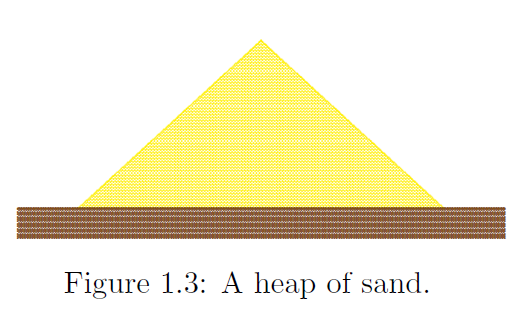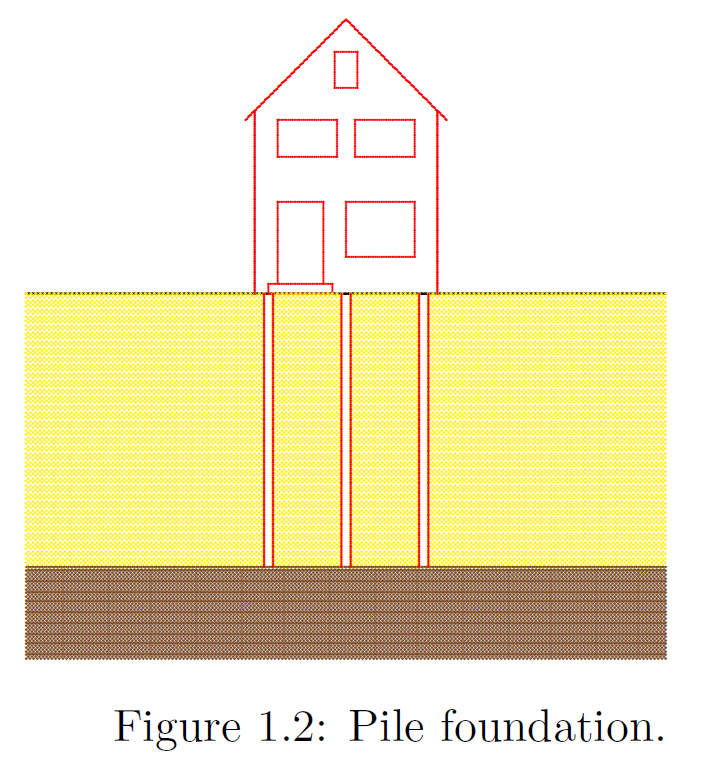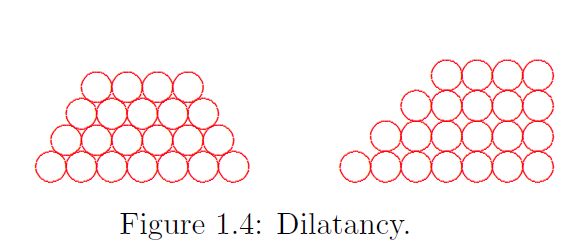Soil mechanics has become a distinct and separate branch of engineering mechanics because soils have a number of special properties, which distinguish the material from other materials. Its development has also been stimulated, of course, by the wide range of applications of soil engineering in civil engineering, as all structures require a sound foundation and should transfer its loads to the soil. The most important special properties of soils will be described briefly in this chapter. In further chapters they will be treated in greater detail, concentrating on quantitative methods of analysis.
1.3.1 Stiffness dependent upon stress level
Many engineering materials, such as metals, but also concrete and wood, exhibit linear stress-strain-behavior, at least up to a certain stress level. This means that the deformations will be twice as large if the stresses are twice as large. This property is described by Hooke’s law, and the materials are called linear elastic. Soils do not satisfy this law. For instance, in compression soil becomes gradually stiffer. At the surface sand will slip easily through the fingers, but under a certain compressive stress it gains an ever increasing stiffness and strength. This is mainly caused by the increase of the forces between the individual particles, which gives the structure of particles an increasing strength. This property is used in daily life by the packaging of coffee and other granular materials by a plastic envelope, and the application of vacuum inside the package. The package becomes very hard when the air is evacuated from it. In civil engineering the non-linear property is used to great advantage in the pile foundation for a building on very soft soil, underlain by a layer of sand. In the sand below a thick deposit of soft clay the stress level is high, due to the weight of the clay. This makes the sand very hard and strong, and it is possible to apply large compressive forces to the piles, provided that they are long enough to reach well into the sand.
1.3.2 Shear
In compression soils become gradually stiffer. In shear, however, soils become gradually softer, and if the shear stresses reach a certain level, with respect to the normal stresses, it is even possible that failure of the soil mass occurs. This means that the slope of a sand heap, for instance in a depot or in a dam, can not be larger than about 30 or 40 degrees. The reason for this is that particles would slide over each other at greater slopes. As a consequence of this phenomenon many countries in deltas of large rivers are very flat. It has also caused the failure of dams and embankments all over the world, sometimes with very serious consequences for the local population. Especially dangerous is that in very fine materials, such as clay, a steep slope is often possible for some time, due to capillary pressures in the water, but after some time these capillary pressures may vanish (perhaps because of rain), and the slope will fail. A positive application of the failure of soils in shear is the construction of guard rails along highways. After a collision by a vehicle the foundation of the guard rail will rotate in the soil due to the large shear stresses between this foundation and the soil body around it. This will dissipate large amounts of energy (into heat), creating a permanent deformation of the foundation of the rail, but the passengers, and the car, may be unharmed. Of course, the guard rail must be repaired after the collision, which can relatively easily be done with the aid of a heavy vehicle.
1.3.3 Dilatancy
Shear deformations of soils often are accompanied by volume changes. Loose sand has a tendency to contract to a smaller volume, and densely packed sand can practically deform only when the volume expands somewhat, making the sand looser. This is called dilatancy, a phenomenon discovered by Reynolds, in 1885. This property causes the soil around a human foot on the beach near the water line to be drawn dry during walking. The densely packed sand is loaded by the weight of the foot, which causes a shear deformation, which in turn causes a volume expansion, which sucks in some water from the surrounding soil. The expansion of a dense soil during shear is shown in Figure 1.4. The space between the particles increases when they shear over each other. On the other hand a very loose assembly of sand particles will have a tendency to collapse when it is sheared, with a decrease of the volume. Such volume deformations may be especially dangerous when the soil is saturated with water. The tendency for volume decrease then may lead to a large increase in the pore water pressures. Many geotechnical accidents have been caused by increasing pore water pressures. During earth quakes in Japan, for instance, saturated sand is sometimes densified in a short time, which causes large pore pressures to develop, so that the sand particles may start to float in the water. This phenomenon is called liquefaction. In the Netherlands the sand in the channels in the Eastern Scheldt estuary was very loose, which required large densification works before the construction of the storm surge barrier. Also, the sand used to create the airport Tjek Lap Kok in Hongkong had to be densified before the construction of the runways and the facilities of the airport.
1.3.4 Creep
The deformations of a soil often depend upon time, even under a constant load. This is called creep. Clay and peat exhibit this phenomenon.
It causes structures founded on soft soils to show ever increasing settlements. A new road, built on a soft soil, will continue to settle for many years. For buildings such settlements are particular damaging when they are not uniform, as this may lead to cracks in the building.
The building of dikes in the Netherlands, on compressible layers of clay and peat, results in settlements of these layers that continue for many decades. In order to maintain the level of the crest of the dikes, they must be raised after a number of years. This results in increasing stresses in the subsoil, and therefore causes additional settlements. This process will continue forever. Before the construction of the dikes the land was flooded now and then, with sediment being deposited on the land. This process has been stopped by man building dikes. Safety has an ever increasing price.
Sand and rock show practically no creep, except at very high stress levels. This may be relevant when predicting the deformation of porous layers from which gas or oil are extracted.
1.3.5 Groundwater
A special characteristic of soil is that water may be present in the pores of the soil. This water contributes to the stress transfer in the soil. It may also be flowing with respect to the granular particles, which creates friction stresses between the fluid and the solid material. In many cases soil must be considered as a two phase material. As it takes some time before water can be expelled from a soil mass, the presence of water usually prevents rapid volume changes.
In many cases the influence of the groundwater has been very large. In 1953 in the Netherlands many dikes in the south-west of the country failed because water flowed over them, penetrated the soil, and then flowed through the dike, with a friction force acting upon the dike material. see Figure 1.5. The force of the water on and inside the dike made the slope slide down, so that the dike lost its water retaining capacity, and the low lying land was flooded in a short time.
In other countries of the world large dams have sometimes failed also because of rising water tables in the interior of the dam (for example, the Teton Valley Dam in the USA, in which water could enter the coarse dam material because of a leaky clay core). Even excessive rainfall may fill up a dam, as happened near Aberfan in Wales in 1966, when a dam of mine tailings collapsed onto the village.
It is also very important that lowering the water pressures in a soil, for instance by the production of groundwater for drinking purposes, leads to an increase of the stresses between the particles, which results in settlements of the soil. This happens in many big cities, such as Venice and Bangkok, that may be threatened to be swallowed by the sea. It also occurs when a groundwater table is temporarily lowered for the construction of a dry excavation. Buildings in the vicinity of the excavation may be damaged by lowering the groundwater table. On a different scale the same phenomenon occurs in gas or oil fields, where the production of gas or oil leads to a volume decrease of the reservoir, and thus to subsidence of the soil. The production of natural gas from the large reservoir in Groningen is estimated to result in a subsidence of about 50 cm in the production time of the reservoir.
1.3.6 Unknown initial stresses
 Soil is a natural material, created in historical times by various geological processes. Therefore the initial state of stress is often not uniform, and often even partly unknown. Because of the non-linear behavior of the material, mentioned above, the initial stresses in the soil are of great importance for the determination of soil behavior under additional loads. These initial stresses depend upon geological history, which is never exactly known, and this causes considerable uncertainty. In particular, the initial horizontal stresses in a soil mass are usually unknown. The initial vertical stresses may be determined by the weight of the overlying layers. This means that the stresses increase with depth, and therefore stiffness and strength also increase with depth. The horizontal stresses, however, usually remain largely unknown. When the soil has been compressed horizontally in earlier times, it can be expected that the horizontal stress is high, but when the soil is known to have spread out, the horizontal stresses may be very low. Together with the stress dependency of the soil behavior all this means that there may be considerable uncertainty about the initial behavior of a soil mass. It may also be noted that further theoretical study can not provide much help in this matter. Studying field history, or visiting the site, and talking to local people, may be more helpful.
Soil is a natural material, created in historical times by various geological processes. Therefore the initial state of stress is often not uniform, and often even partly unknown. Because of the non-linear behavior of the material, mentioned above, the initial stresses in the soil are of great importance for the determination of soil behavior under additional loads. These initial stresses depend upon geological history, which is never exactly known, and this causes considerable uncertainty. In particular, the initial horizontal stresses in a soil mass are usually unknown. The initial vertical stresses may be determined by the weight of the overlying layers. This means that the stresses increase with depth, and therefore stiffness and strength also increase with depth. The horizontal stresses, however, usually remain largely unknown. When the soil has been compressed horizontally in earlier times, it can be expected that the horizontal stress is high, but when the soil is known to have spread out, the horizontal stresses may be very low. Together with the stress dependency of the soil behavior all this means that there may be considerable uncertainty about the initial behavior of a soil mass. It may also be noted that further theoretical study can not provide much help in this matter. Studying field history, or visiting the site, and talking to local people, may be more helpful.
1.3.7 Variability
The creation of soil by ancient geological processes also means that soil properties may be rather different on different locations. Even in two very close locations the soil properties may be completely different, for instance when an ancient river channel has been filled with sand deposits. Sometimes the course of an ancient river can be traced on the surface of a soil, but often it can not be seen at the surface. When an embankment is built on such a soil, it can be expected that the settlements will vary, depending upon the local material in the subsoil. The variability of soil properties may also be the result of a heavy local load in the past.
A global impression of the soil composition can be obtained from geological maps. These indicate the geological history and character of the soils. Together with geological knowledge and experience this may give a first indication of the soil properties. Other geological information may also be helpful. Large areas of Western Europe have, for instance, been covered by thick layers of ice in earlier ice ages, and this means that the soils in these areas have been subject to a preload of considerable magnitude, and therefore may be rather dense. An accurate determination of soil properties can not be made from desk studies. It requires testing of the actual soils in the laboratory, using samples taken from the field, or testing of the soil in the field (in situ). This will be elaborated in later chapters.
Problem 1.1 In times of high water in the rivers in The Netherlands, when the water table rises practically to the crest of the dikes, local authorities sometimes put sand bags on top of the dike. Is that useful?
Problem 1.2 Another measure to prevent failure of a dike during high floods, is to place large sheets of plastic on the slope of the dike. On which side?
Problem 1.3 Will the horizontal stress in the soil mass near a deep river be relatively large or small?
Problem 1.4 The soil at the bottom of the North Sea is often much stiffer in the Northern parts (near Norway) than it is in the Southern parts (near London). What can be the cause?
Problem 1.5 A possible explanation of the leaning of the Pisa tower is that the subsoil contains a compressible clay layer of variable thickness. On what side of the tower would that clay layer be thickest?
Problem 1.6 Another explanation for the leaning of the Pisa tower is that in earlier ages (before the start of the building of the tower, in 1400) a heavy structure stood near that location. On which side of the tower would that building have been?
Problem 1.7 In many cities of the world leaning towers may be found, though nowhere so spectacular as in Pisa.
An example is shown in Figure 1.8 of the tower of the Old Church of Delft, along the canal Oude Delft. Can you imagine what is the probable cause in this case, and can you suggest a simple technical solution to prevent further leaning?


